Business
$15 an hour isn’t enough: U.S. workers need to earn a living wage on August 25, 2023 at 12:51 pm Business News | The Hill

As cost increases persist and workers try to keep up, buzzwords like “poverty wage,” “minimum wage” and “living wage” are coming back into the lexicon, shaping conversations about what it means to make enough and who decides where to draw the line.
The federal minimum wage, which was last raised in 2009, stands at $7.25 an hour.
A full-time employee, working an average of 40 hours per week on minimum wage, makes $15,000 annually (which puts these workers below the poverty line in many states).
A recent study from SmartAsset found that the average American worker needs $68,499 in after-tax income to live comfortably. That works out to around $85,000 in total income––assuming a 20% tax hit.
A third of Americans make less than $15 per hour
The fact is that over a third of the total workforce (52 million Americans) makes less than $15 per hour.
The people most impacted by low wages are historically marginalized populations: women and people of color. More than half (58.7%) of minimum wage workers in the U.S. are women, 21.8% are Hispanic, 12.2% are Black and 14.4% are multiracial and/or Native.
These are the people suffering the worst sticker shock at the grocery store and the gas pump, choosing between rent and utilities. What’s more, current federal law still allows U.S. employers to pay sub-minimum wages to nearly a million workers.
This lower “tipped minimum wage” is a long-standing weakness of the federal minimum wage and many state minimum wages that is fundamentally inequitable.
The Raise the Wage Act of 2023, introduced in the U.S. House of Representatives and U.S. Senate on July 25th, aims to gradually raise the federal minimum wage to $17 an hour by 2028.
The bill will also aim to gradually raise and then eliminate subminimum wages for tipped workers, workers with disabilities, and youth workers, so that all workers covered by the Fair Labor Standards Act (FLSA) will be at the same wage level.
Raising the income of millions of workers
According to a report by the Economic Policy Institute, a national $15 minimum wage by 2025 would raise the incomes of tens of millions of workers, including servers in restaurants, grocery store employees, and essential health care workers as well as two million direct care workers who provide long-term services and supports.
Overall, the outsize impact would be on workers above the age of 25, women, workers of color, and those living below the poverty line. More than a million single-parent households will also benefit from the raise.
In the absence of federal action, many cities and states (through legislation, ballot measure or annual cost of living adjustments) have already bumped up their own minimum wages—some of them to double the federal baseline.
Thirty states in all have raised their minimum wage including 23 states that imposed a hike at the start of this year.
On July 1st, Oregon raised its minimum wage to $14.20. Portland’s minimum wage went up to $15.45. Washington, D.C.’s minimum wage rose to $17. Nevada increased to $11.25. Connecticut’s minimum wage went to $15.00.
Inflation adjustments also happened in 12 locales in California including San Francisco ($18.07), Los Angeles ($16.78), and West Hollywood ($19.08), which now has the highest minimum wage in the country.
Supporting working families
However, even these hikes are inadequate to truly support working families. A true living wage that supports a basic standard of living without food and housing insecurity would be between $20 and $26 or more per hour, depending on the state.
For example, the most expensive places to live in the U.S. are Hawaii and Washington D.C., where you’d need to make $38.57 per hour and $39.41, respectively, to meet the basic necessities as an adult with one child.
Two states that have the lowest cost of living are South Dakota and Mississippi, where you would still need to make $27.06 and $26.74 to meet basic needs.
In many places, $15 per hour wouldn’t be a sufficient living wage for a single person. Even without children, living wages in Hawaii and Washington D.C. are $19.43 and $20.49, respectively.
Start the conversation with living wages
Living wage should be the starting point in the conversation of wages. And beyond wages, this conversation should engage all of us to consider what it really means to “live”.
Quality of life should be accessible to all, as should the need for affordable access to healthy food, clean water, safe housing, universal health care, paid sick and vacation leave, affordable childcare––and more––for everyone.
If an equitable workplace is key for you, it’s worth checking out opportunities with organizations committed to positive change in today’s working culture. Your first stop? Head for The Hill Jobs Board where you can browse hundreds of jobs right now. Here are three hiring this week.
Deputy Director of Government Relations, Bread for the World, Washington
Bread for the World is looking to recruit a Deputy Director of Government Relations to help provide departmental leadership and implement policy and legislative strategy on domestic or international issues affecting people experiencing hunger and poverty in the U.S. and abroad. The ideal candidate will have a bachelor’s degree in public policy or related areas, although a master’s degree or other post-graduate degree is preferred. To apply, you’ll need eight years of Hill or lobbying experience, as well as staff supervisory and management experience.
Director, Governmental Affairs & Public Policy, American Gas Association, Washington
The American Gas Association is seeking a Director, Governmental Affairs & Public Policy to serve as an advocate for the natural gas industry who will represent AGA before the U.S. Congress, administrative agencies of the federal government and key policymakers and stakeholders. A qualified candidate’s resume will include an undergraduate degree, at least five years of experience with federal lobbying, experience working with Members of Congress, committee staff, and personal office congressional staff, and experience in the energy sector.
Associate Deputy Chief Financial Officer, Office of The Chief Financial Officer, MD
The Office of the Chief Financial Officer has an open role for an Associate Deputy Chief Financial Officer in its Maryland office. The successful hire will be second in command to the Deputy Chief Financial Officer, responsible for providing oversight of the day-to-day operational activities within OBP. To apply you’ll need a Bachelor’s degree in economics, accounting, business administration, finance, or related field as well as nine years of financial/budgetary experience (ideally with a federal or state agency).
Lobbying, Business As cost increases persist and workers try to keep up, buzzwords like “poverty wage,” “minimum wage” and “living wage” are coming back into the lexicon, shaping conversations about what it means to make enough and who decides where to draw the line. The federal minimum wage, which was last raised in 2009, stands at $7.25…
Business
Google Accused Of Favoring White, Asian Staff As It Reaches $28 Million Deal That Excludes Black Workers

Google has tentatively agreed to a $28 million settlement in a California class‑action lawsuit alleging that white and Asian employees were routinely paid more and placed on faster career tracks than colleagues from other racial and ethnic backgrounds.
- A Santa Clara County Superior Court judge has granted preliminary approval, calling the deal “fair” and noting that it could cover more than 6,600 current and former Google workers employed in the state between 2018 and 2024.

How The Discrimination Claims Emerged
The lawsuit was brought by former Google employee Ana Cantu, who identifies as Mexican and racially Indigenous and worked in people operations and cloud departments for about seven years. Cantu alleges that despite strong performance, she remained stuck at the same level while white and Asian colleagues doing similar work received higher pay, higher “levels,” and more frequent promotions.
Cantu’s complaint claims that Latino, Indigenous, Native American, Native Hawaiian, Pacific Islander, and Alaska Native employees were systematically underpaid compared with white and Asian coworkers performing substantially similar roles. The suit also says employees who raised concerns about pay and leveling saw raises and promotions withheld, reinforcing what plaintiffs describe as a two‑tiered system inside the company.
Why Black Employees Were Left Out
Cantu’s legal team ultimately agreed to narrow the class to employees whose race and ethnicity were “most closely aligned” with hers, a condition that cleared the path to the current settlement.

The judge noted that Black employees were explicitly excluded from the settlement class after negotiations, meaning they will not share in the $28 million payout even though they were named in earlier versions of the case. Separate litigation on behalf of Black Google employees alleging racial bias in pay and promotions remains pending, leaving their claims to be resolved in a different forum.
What The Settlement Provides
Of the $28 million total, about $20.4 million is expected to be distributed to eligible class members after legal fees and penalties are deducted. Eligible workers include those in California who self‑identified as Hispanic, Latinx, Indigenous, Native American, American Indian, Native Hawaiian, Pacific Islander, and/or Alaska Native during the covered period.
Beyond cash payments, Google has also agreed to take steps aimed at addressing the alleged disparities, including reviewing pay and leveling practices for racial and ethnic gaps. The settlement still needs final court approval at a hearing scheduled for later this year, and affected employees will have a chance to opt out or object before any money is distributed.
H2: Google’s Response And The Broader Stakes
A Google spokesperson has said the company disputes the allegations but chose to settle in order to move forward, while reiterating its public commitment to fair pay, hiring, and advancement for all employees. The company has emphasized ongoing internal audits and equity initiatives, though plaintiffs argue those efforts did not prevent or correct the disparities outlined in the lawsuit.
For many observers, the exclusion of Black workers from the settlement highlights the legal and strategic complexities of class‑action discrimination cases, especially in large, diverse workplaces. The outcome of the remaining lawsuit brought on behalf of Black employees, alongside this $28 million deal, will help define how one of the world’s most powerful tech companies is held accountable for alleged racial inequities in pay and promotion.
Business
Luana Lopes Lara: How a 29‑Year‑Old Became the Youngest Self‑Made Woman Billionaire

At just 29, Luana Lopes Lara has taken a title that usually belongs to pop stars and consumer‑app founders.
Multiple business outlets now recognize her as the world’s youngest self‑made woman billionaire, after her company Kalshi hit an 11 billion dollar valuation in a new funding round.
That round, a 1 billion dollar Series E led by Paradigm with Sequoia Capital, Andreessen Horowitz, CapitalG and others participating, instantly pushed both co‑founders into the three‑comma club. Estimates place Luana’s personal stake at roughly 12 percent of Kalshi, valuing her net worth at about 1.3 billion dollars—wealth tied directly to equity she helped create rather than inheritance.

Kalshi itself is a big part of why her ascent matters.
Founded in 2019, the New York–based company runs a federally regulated prediction‑market exchange where users trade yes‑or‑no contracts on real‑world events, from inflation reports to elections and sports outcomes.
As of late 2025, the platform has reached around 50 billion dollars in annualized trading volume, a thousand‑fold jump from roughly 300 million the year before, according to figures cited in TechCrunch and other financial press. That hyper‑growth convinced investors that event contracts are more than a niche curiosity, and it is this conviction—expressed in billions of dollars of new capital—that turned Luana’s share of Kalshi into a billion‑dollar fortune almost overnight.
Her path to that point is unusually demanding even by founder standards. Luana grew up in Brazil and trained at the Bolshoi Theater School’s Brazilian campus, where reports say she spent up to 13 hours a day in class and rehearsal, competing for places in a program that accepts fewer than 3 percent of applicants. After a stint dancing professionally in Austria, she pivoted into academics, enrolling at the Massachusetts Institute of Technology to study computer science and mathematics and later completing a master’s in engineering.
During summers she interned at major firms including Bridgewater Associates and Citadel, gaining a front‑row view of how global macro traders constantly bet on future events—but without a simple, regulated way for ordinary people to do the same.

That realization shaped Kalshi’s founding thesis and ultimately her billionaire status. Together with co‑founder Tarek Mansour, whom she met at MIT, Luana spent years persuading lawyers and U.S. regulators that a fully legal event‑trading exchange could exist under commodities law. Reports say more than 60 law firms turned them down before one agreed to help, and the company then spent roughly three years in licensing discussions with the Commodity Futures Trading Commission before gaining approval. The payoff is visible in 2025’s numbers: an 11‑billion‑dollar valuation, a 1‑billion‑dollar fresh capital injection, and a founder’s stake that makes Luana Lopes Lara not just a compelling story but a data point in how fast wealth can now be created at the intersection of finance, regulation, and software.
Business
Harvard Grads Jobless? How AI & Ghost Jobs Broke Hiring

America’s job market is facing an unprecedented crisis—and nowhere is this more painfully obvious than at Harvard, the world’s gold standard for elite education. A stunning 25% of Harvard’s MBA class of 2025 remains unemployed months after graduation, the highest rate recorded in university history. The Ivy League dream has become a harsh wakeup call, and it’s sending shockwaves across the professional landscape.

Jobless at the Top: Why Graduates Can’t Find Work
For decades, a Harvard diploma was considered a golden ticket. Now, graduates send out hundreds of résumés, often from their parents’ homes, only to get ghosted or auto-rejected by machines. Only 30% of all 2025 graduates nationally have found full-time work in their field, and nearly half feel unprepared for the workforce. “Go to college, get a good job“—that promise is slipping away, even for the smartest and most driven.
Tech’s Iron Grip: ATS and AI Gatekeepers
Applicant tracking systems (ATS) and AI algorithms have become ruthless gatekeepers. If a résumé doesn’t perfectly match the keywords or formatting demanded by the bots, it never reaches human eyes. The age of human connection is gone—now, you’re just a data point to be sorted and discarded.
AI screening has gone beyond basic qualifications. New tools “read” for inferred personality and tone, rejecting candidates for reasons they never see. Worse, up to half of online job listings may be fake—created simply to collect résumés, pad company metrics, or fulfill compliance without ever intending to fill the role.
The Experience Trap: Entry-Level Jobs Require Years
It’s not just Harvard grads who are hurting. Entry-level roles demand years of experience, unpaid internships, and portfolios that resemble a seasoned professional, not a fresh graduate. A bachelor’s degree, once the key to entry, is now just the price of admission. Overqualified candidates compete for underpaid jobs, often just to survive.
One Harvard MBA described applying to 1,000 jobs with no results. Companies, inundated by applications, are now so selective that only those who precisely “game the system” have a shot. This has fundamentally flipped the hiring pyramid: enormous demand for experience, shrinking chances for new entrants, and a brutal gauntlet for anyone not perfectly groomed by internships and coaching.
Burnout Before Day One
The cost is more than financial—mental health and optimism are collapsing among the newest generation of workers. Many come out of elite programs and immediately end up in jobs that don’t require degrees, or take positions far below their qualifications just to pay the bills. There’s a sense of burnout before careers even begin, trapping talent in a cycle of exhaustion, frustration, and disillusionment.
Cultural Collapse: From Relationships to Algorithms
What’s really broken? The culture of hiring itself. Companies have traded trust, mentorship, and relationships for metrics, optimizations, and cost-cutting. Managers no longer hire on potential—they rely on machines, rankings, and personality tests that filter out individuality and reward those who play the algorithmic game best.
AI has automated the very entry-level work that used to build careers—research, drafting, and analysis—and erased the first rung of the professional ladder for thousands of new graduates. The result is a workforce filled with people who know how to pass tests, not necessarily solve problems or drive innovation.
The Ghost Job Phenomenon
Up to half of all listings for entry-level jobs may be “ghost jobs”—positions posted online for optics, compliance, or future needs, but never intended for real hiring. This means millions of job seekers spend hours on applications destined for digital purgatory, further fueling exhaustion and cynicism.
Not Lazy—Just Locked Out
Despite the headlines, the new class of unemployed graduates is not lazy or entitled—they are overqualified, underleveraged, and battered by a broken process. Harvard’s brand means less to AI and ATS systems than the right keyword or résumé format. Human judgment has been sidelined; individuality is filtered out.

What’s Next? Back to Human Connection
Unless companies rediscover the value of human potential, mentorship, and relationships, the job search will remain a brutal numbers game—one that even the “best and brightest” struggle to win. The current system doesn’t just hurt workers—it holds companies back from hiring bold, creative talent who don’t fit perfect digital boxes.
Key Facts:
- 25% of Harvard MBAs unemployed, highest on record
- Only 30% of 2025 grads nationwide have jobs in their field
- Nearly half of grads feel unprepared for real work
- Up to 50% of entry-level listings are “ghost jobs”
- AI and ATS have replaced human judgment at most companies
If you’ve felt this struggle—or see it happening around you—share your story in the comments. And make sure to subscribe for more deep dives on the reality of today’s economy and job market.
This is not just a Harvard problem. It’s a sign that America’s job engine is running on empty, and it’s time to reboot—before another generation is locked out.

 Entertainment4 weeks ago
Entertainment4 weeks agoWicked Sequel Disappoints Fans: Audience Verdict on For Good

 Entertainment4 weeks ago
Entertainment4 weeks agoAriana & Cynthia Say They’re in a ‘Non‑Demi Curious, Semi‑Binary’ Relationship… WTF Does That Even Mean?

 News4 weeks ago
News4 weeks agoMexico Bans Dophin Shows Nationwide

 Entertainment3 weeks ago
Entertainment3 weeks agoColombia’s ‘Doll’ Arrest: Police Say a 23-Year-Old Orchestrated Hits, Including Her Ex’s Murder

 Entertainment4 weeks ago
Entertainment4 weeks agoHow The Grinch Became The Richest Christmas Movie Ever

 Entertainment4 weeks ago
Entertainment4 weeks agoMiley Cyrus Is Engaged to Maxx Morando

 Business3 weeks ago
Business3 weeks agoLuana Lopes Lara: How a 29‑Year‑Old Became the Youngest Self‑Made Woman Billionaire

 News4 weeks ago
News4 weeks agoUS May Completely Cut Income Tax Due to Tariff Revenue






























